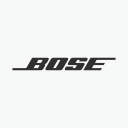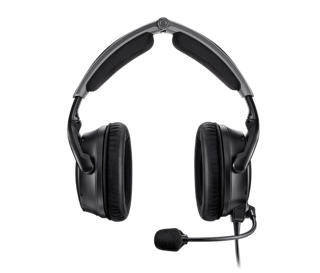Bose A30 Aviation Headset
Overview

Lightweight design with low clamping force
A full-sized around-ear headset with 20% less clamping force than the Bose A20 Headset.
Unmatched audio clarity with active equalisation
Incoming signals are shaped and equalised for enhanced clarity and intelligibility.
FAA TSO and EASA E/TSO-C139a certified
Certified for its performance in challenging flight environments.
Toolless, side swappable down cable and mic
Boom mic and down cable can be mounted on either side of the headset without tools.
Precision-focused noise cancelling microphone
Engineered for aircraft with “hot mic” or PTT systems to increase clarity and reduce background noise during transmission.
Active noise cancellation with three selectable modes
Adjustable noise cancellation modes to accommodate nearly any environment or personal preference.
With a sleek, modern design and a toolless side swappable mic, the A30 is engineered to provide versatility and a new level of performance in nearly every cockpit environment. Additionally, the headset is made with materials chosen for strength and durability without the bulk and clamping force of typical aviation headsets.
FAQs
What’s the difference between the A30 Aviation Headset and its predecessor, the A20 Aviation Headset?
The A30 Aviation Headset is the evolution of the A20. Its sleek, modern design significantly improves long-term comfort with a lower on-head weight and reduced clamping force. It also features three modes of active noise reduction and tap control for talk-through communication.
The A30 upholds the acclaimed noise reduction and state-of-the-art materials and electronic capabilities of the A20. Each of these advancements helped create the best combination of noise reduction and audio clarity on the market.
Does the Bose A30 Aviation Headset have volume knobs?
Yes. Similar to the A20, there are left and right sensitivity adjustment wheels on the control module. These can be used to accommodate differential hearing loss and multiple radio inputs in stereo mode or to help users control radio inputs in one ear to hear outside sound sources more clearly. For larger adjustments, volume tuning is typically done on the audio panel or for each radio.
Can the Bose A30 Aviation Headset be used in all types of aircraft?
Yes. The A30 is optimised for use in general, military and commercial aviation aircraft. It can be used in both fixed-wing aircraft and in helicopters. It can be purchased with different connection options, including Dual G/A, 6-pin LEMO and 5-pin XLR. The A30 is not recommended for open-cockpit aircraft where the headset is in the direct path of the wind and slipstream.
How many different versions and configurations are available for the Bose A30 Aviation Headset?
The Bose A30 comes in many variations, and customers can choose different configurations based on connector, cable, microphone and module (Bluetooth or non-Bluetooth). The most popular aircraft connection option is dual G/A, but flexible power versions with auto-on capabilities are also available in 6-pin and 5-pin XLR configurations.
The most common connection configurations are:
● Dual plug (PJ 068 and ¼ inch stereo): With the dual plug, two AA alkaline batteries provide a minimum of 45 hours of operation while flying. This version is user-configured for stereo or mono audio and is commonly used across all aircraft types.
● XLR 5-pin: This configuration, often called the Airbus plug, is a mono connection that’s powered by the aircraft or batteries, depending on the aircraft’s capabilities. When disconnected, the flexible power feature allows pilots to switch seamlessly between aircraft and battery power.
● U-174: The U-174 is a single-plug configuration commonly used in both military aircraft and several helicopter models.
● (LEMO) 6-pin connector: With this option, the headset is connected to the aircraft via a 6-pin connector and is powered directly from the aircraft. Two AA alkaline batteries can also be used to enhance flexibility. When disconnected, the flexible power feature allows pilots to switch seamlessly between aircraft and battery power.*
*Bose adapters are available to convert a 6-pin connector to either a dual G/A plug or a U-174 for additional connection flexibility.
Can I switch the microphone to either side?
Yes. The integrated boom mic and cable can be attached to either side of the headset with the toolless connector mechanism in a few simple steps.
Does the A30 Aviation Headset have an equaliser (EQ) or a way to equalise the headset audio?
The Bose A30 Aviation Headset has multiple built-in equalisation circuits. The primary ICS/radio communications path is designed to meet the latest TSO standard and to optimise voice intelligibility. An additional active EQ helps optimise the experience through the secondary (Bluetooth) audio path for wireless audio sources.
How much noise reduction does the Bose A30 Aviation Headset provide? What is the attenuation at different frequencies?
The Bose A30 Aviation Headset provides three modes of user-selectable noise cancellation that were individually engineered for specific use cases. “Low” helps optimise interpersonal communication outside the use of an intercom system. “Medium” provides the most consistent amount of reduction across a wide range of frequencies, and “High” provides the most active noise reduction to maximise the signal-to-noise ratio for radio communication. All three modes have been engineered for distinct uses.
Bose does not make claims about the mode of noise reduction. We encourage pilots to try the product in a variety of aircraft to experience the dramatic performance and capability of each mode for themselves.
What makes the A30 Aviation Headset so comfortable?
Overall, the Bose A30 Aviation Headset is one of the smallest, lowest-clamping and lightest around-ear active noise cancelling headsets on the market – it’s a balance of function and comfort without sacrificing stability.
The headset’s angled earcups follow the contours of pilots’ heads, and the intentional shape of the headband pads helps achieve the highest level of comfort in the lowest possible on-head weight. Additionally, the A30 has distinct left and right earcups with a quick release and a side swappable mic for improved comfort and ergonomics.
What kind of microphone does the Bose A30 Aviation Headset have?
The A30 uses a noise cancelling electret microphone (often called a high-impedance microphone), which is typical for aircraft. It is optimised to reject far-field noise and improve performance when used with “hot mic” systems. A 5-ohm and a 150-ohm dynamic microphone are available in specific configurations.
What is the battery life of the Bose A30 Aviation Headset?
The A30 operates for a minimum of 45 hours from two AA alkaline batteries in typical aircraft noise. With continuous operation of the Bluetooth function, battery life will last 25+ hours. As always, battery life varies with the type of battery, noise environment and features used during flight. The headset has a battery life indicator light to signal when batteries need to be replaced.
Can I interchange the control modules or other parts and accessories from my A20 or ProFlight Headsets with those from the A30?
No. The control module can be used only with the model for which it was built. Although some of the cushions and parts may be forced onto the Bose A30 Aviation Headset, they were not designed for this product.
































